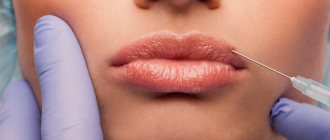Rehabilitation after breast correction involves some restrictions, which are gradually removed during 6 months of recovery, so every woman should know what not to do after mammoplasty. After all, the flawless and desired result of aesthetic surgery is a joint work of the plastic surgeon and the patient. It is extremely important to strictly follow all the doctor’s recommendations and consult with him on basic issues: when, after breast augmentation, can you remove the compression underwear and replace it with a new beautiful bra with underwire? What medications should I take? How to care for your skin and when can you resume sports? Unfortunately, there are no unambiguous and generalized answers to these questions, since the course of rehabilitation is extremely individual. Specialists of the clinic named after. N.I. Pirogov is always in touch and guides her patients from the moment of initial consultation until the successful completion of rehabilitation.
How does a breast augmentation consultation work?
Goals:
- acquaintance and establishment of a trusting understanding between the patient and the doctor;
- collection of necessary anamnestic data;
- determining the expected outcome of the operation and the patient’s motivations;
- discussion of the features of the operation and the postoperative period, possible complications, for example, analysis of some clinical cases from the surgeon’s practice;
- determining future breast volume using external sizers;
- measuring the main dimensions of the chest and chest, taking into account anatomical features;
- selection of implants based on the analysis;
- photo demonstration of the results of operations performed and their analysis;
- written documentation of the consultation, handed over with the examination plan;
- 3D modeling.
“And why do they ask me about everything in such detail...?”
During the consultation, the doctor asks questions that are directly related to the planned operation or its preparation. For example, typical questions include:
- Have you ever been satisfied with your breasts?
- How do your loved ones feel about your intentions?
- How long have you been thinking about breast surgery?
- Are you planning a pregnancy in the near future?
- Do you have any children ?
- Have you breastfed and if yes, for how long?
- What was the maximum breast size and which breast had the most milk?
- What changes have happened to your breasts?
- Are there any difficulties when choosing underwear?
- Is your weight stable?
- How do breasts change during menstruation?
- Have you had any plastic surgery and if yes, how do you like the result or what surgeries might you still be planning?
- Maybe someone you know has already had breast surgery?
“Now I remember, when was the last time I saw a doctor...?”
Information about previous or existing diseases may indicate the presence of contraindications to surgery. Observation by specialized specialists or ongoing treatment may also require additional examination.
It is advisable to carry out an examination of the mammary glands once a year, for example, the simplest is an ultrasound of the mammary glands.
“Here, doctor, look what I want... but I don’t like it this way...!”
Also during the consultation, it is important to carefully study the patient’s wishes and the expected result. You can tell us about the breast shape and size you dream about. Patients often bring photographs of their breasts that they like, for example, photographs of models, which also helps to more clearly determine the size and shape of the breast. This also helps to understand what result of the operation you would not like to receive.
Remember that with a responsible attitude to planning the operation, you will always be satisfied with the result. Being informed before surgery helps you make the right decisions.
“And on Monday I have to go to work... but can I go to the gym...?”
Of great importance is information about the features of the postoperative period, which usually proceeds smoothly and quickly. After just two to three weeks, patients “forget” about the operation. In fact, the healing processes in tissues continue much longer, for example, fixation of an implant in tissues and ingrowth of connective tissue into its shell occurs within 3-5 months. Wearing compression garments prevents sagging and displacement of the implant and helps to refine the shape of the breast after surgery or reduce asymmetry. Limited loads on the shoulder girdle, for example, swimming a month after surgery, help to form a more delicate capsule around the implant, while more intense loads are recommended from the 2-3rd month. After the operation, it is necessary to conduct an ultrasound examination after 2, 6 and 12 months, then every year. Of great importance is the concept that the breast is a dynamic organ and can change over time. All this knowledge gained during the consultation helps you get not only a beautiful, but also a stable result that you will be happy with for the rest of your life. You will also be able to see real implants from various manufacturers, hold them in your hands, and test them for strength (usually each surgeon has many implants, which he will definitely tell you about).
“This is what I like best... what about you, doctor?”
How can you see future breasts? A set of external sizers of different sizes, which are inserted into a specially selected elastic T-shirt, is effectively suitable for this. Thanks to this simple technique, the patient can see in the mirror how proportionally the selected breast volume suits her. Sizers accurately convey the volume and weight of implants and significantly help visualize the result of the operation. Using sizers, you can also determine the size of your future bra cup using a special table.
External sizers
Trying on external sizers before surgery
Result after surgery
“... really a little lower on the left... I didn’t even notice this before?!”
The next stage of the consultation is to measure the size of the breast and rib cage, taking into account anatomical features. You will have to strip to the waist! Of great importance to achieve a stable result of the operation is the selection of an implant in accordance with the size of the original breast. An implant extending beyond the surface tissue can be palpated and visually noticeable. Recently, most patients strive for naturalness when planning surgery. As a rule, every patient has asymmetry, this is also taken into account during the consultation. It can be caused by different heights of the areolas or the inframammary fold located at different levels, or different volumes of the gland's own tissues. Noticeable asymmetry in some cases can be corrected, for example, by selecting different-sized implants or internal tissue transposition, or a slight displacement of one of the inframammary folds. And a small unaccounted for asymmetry, which could have been prevented, may become noticeable after surgery, due to a change in the position of the breast tissue on the implant after surgery. Asymmetry can also be a result of scoliosis.
It is important to assess the volume of covering tissue above the implant; for example, with thin skin and a small amount of fatty tissue in the lateral sections, the implant can be palpated. This sensation can be easily demonstrated by placing 3-4 layers of thick material equal in thickness to your tissues on the edge of the implant.
Therefore, in such cases, it is rational to carry out the lipofilling procedure (injection of one’s own fat) 8-12 months after the operation.
The most important dimensions: girth under the breast, distance from the nipple to the inframammary fold and to the base of the neck, width of the chest area, measurement of the thickness of the integumentary tissue, height. Usually, all measurements taken are drawn on the skin of the chest with a thin marker (you will see everything in the mirror) and washed off after the consultation.
Breast measurement before surgery
Breast measurement after surgery
“Now I can choose the implant myself...!”
When we have drawn the markings and determined the size of the breasts, we can move on to determining the implants themselves. Implants from different manufacturers have different properties and are selected individually. Modern implants from leading manufacturers have a lifetime warranty and do not need to be replaced over time. These are high-tech products that are intact to body tissues and do not cause any diseases. Implants have width, height, projection and lower pole length indicated in centimeters and weight indicated in milliliters. Implant volume from 90 ml. up to 730 ml. in increments of 15-35 ml.
The size of the implants should not exceed the boundaries of the mammary gland; this is especially important in patients with an insufficient amount of integumentary tissue. The main dimensions of the skin “cover” of the breast should not be smaller than the selected implant. As a rule, several implants of similar sizes are suitable for the operation.
The final choice of implant from similar pairs is determined during surgery, based on the parameters of the skin “cover” of the breast. Different sized implants can be selected to correct breast asymmetry. Using a simple test, you can check the volume of your future breasts in accordance with the selected implants at home yourself in front of a mirror.
“I didn’t think that I would learn so many new things, it was interesting...!” or “A whole hour of theory, and at the end there’s also a practical lesson!”
As a result of photographic demonstration of the results of other patients, you can see similar elements or mechanisms of the operation, but remember that only you have such a breast and each patient is unique, and the dynamic changes in the breast over time are unique. For each patient you examined, you will be able to ask questions and evaluate the results in detail at different times after surgery.
“Tomorrow I’ll read everything again and remember”
After the consultation is completed, you will receive a written summary of the consultation with a breast correction plan and examination regimen. You will also have contact information for the surgeon and his assistant, so that you can always call and ask questions that may arise in a few days. Sometimes there is a need for a second consultation.
“Even before plastic surgery, I will be able to see its results”
This became possible thanks to the latest 3D volumetric modeling system of 2014, Vectra-XT. Already at the first consultation you will be able to see a 3D model of your own body with the result of future plastic surgery. Agree, by looking at the shape and size of the future breast it will be much easier to decide on the size of the implant. Thanks to 3D modeling technology, the risk of dissatisfaction with the result of plastic surgery is reduced to a minimum.
Endoscopic breast augmentation using the “Breast without seam” method from consultation to perfection. Comparative characteristics of results after surgery for 4 years.
Important points during the rehabilitation period
In the first days after mammoplasty and subsequent months, proper breast care in the area of postoperative scars is important. This is important for their fastest healing without severe deformations. In the first days, the doctor treats the area of the sutures and changes the bandages; they are prohibited from being removed or wet. If absorbable threads were used, they are not removed; the resulting crust over the seam cannot be torn off until it completely falls off. To stimulate scar healing, your doctor may prescribe special creams. They make the seams less noticeable.
During the first 2-3 months (or longer), you need to wear a compression bra after mammoplasty. For a month they wear it without taking it off, even at night; from the second month it is permissible to take off the underwear at night. This is important so that the implants take their place and take root well, there are no problems with the skin and ligaments, muscles, and blood flow and lymph drainage are normalized.
On the recommendation of a doctor, therapeutic breast massage may be prescribed. Initially, it is carried out by a massage therapist, teaching the woman, then she performs it independently, in the morning. In the first three weeks, movements should be as light as possible, then lymphatic drainage massage techniques are used.
Information materials on the site are posted for informational purposes, not self-medication. Any plastic surgery is a surgical intervention. When deciding to have surgery, be sure to consult with a qualified professional.
Preparing for surgery
Setting the operating parameters of anesthesiological equipment.
Preparing the patient for surgery. Marking.
Assembly of endoscopic equipment for endoscopic breast augmentation.
What is the secret to a comfortable recovery after mammoplasty in our clinic?
Department of Plastic Surgery at the Clinic named after. N.I. Pirogov was opened in 1999. Today in St. Petersburg it is considered the flagship. Our plastic surgeons have successfully performed more than 10 thousand operations, and each work can truly be called “jewelry.” The combination of high quality medical services and affordable prices is one of our main advantages and confirmation of our commitment to the principle of customer focus. We offer our patients:
- services of the best plastic surgeons in the city with impressive experience in the field of aesthetic and reconstructive medicine;
- material and technical equipment of the clinic at the level of leading European medical institutions;
- a wide range of medical specialists whose assistance may be required to perform breast surgery;
- high-comfort rooms for 1 or 2 people;
- availability of its own laboratory and intensive care unit;
- discounts and all inclusive package offers at reduced prices for plastic surgery;
- personal support from a curator for patients from other cities and countries;
- interest-free installments.
If you have any questions, call us at: +7 (812) 320-70-00. Contact center specialists will advise you and help you make an appointment with a plastic surgeon.
Operation
Local anesthesia is administered.
An incision is made in the armpit.
Inserting the endoscope into the chest pocket.
Separation of tissues, including the pectoralis major muscle.
Coagulation of the chest pocket using an endoscopic roller, it allows you to seal even the smallest capillaries and intercostal vessels.
Selection and installation of implants taking into account the anatomical characteristics of the patient.
Result after endoprosthetics of one breast.
Why do keloid scars appear?
Keloid scars are a complication of breast augmentation. Among the reasons for their formation are the following:
- features of the body's immune system,
- hereditary predisposition,
- excessive skin tension in the healing zone,
- suppuration or infection of a postoperative wound.
It should be noted that sutures after mammoplasty rarely turn into keloids. This process mainly has a hereditary predisposition and manifests itself gradually, in some cases up to 2 years. Therefore, with constant monitoring by a doctor, you can notice changes occurring in time and stop their development.
Comparison of results AFTER surgery
Result of the operation after 2 months/1 year/4 years.
Before surgery
2 months after surgery
One year after surgery
4 years after surgery
What does the incision in the armpit through which the implant was installed look like?
Prevention of scar formation
- During the operation, try to minimize the tension on the postoperative sutures. Of course, the very meaning of a brace contradicts this, but we must remember that the tension should be reasonable.
- Breast lifts larger than size 4 will typically have more tension and therefore rougher scarring.
- Careful handling of soft tissues during surgery. It depends entirely on the surgeon.
- Careful suturing of the postoperative wound. Also, the care of the surgeon, but not always the most careful suturing of a postoperative wound guarantees a high-quality scar.
Breast examination after breast augmentation with implants
Every woman should take care of her health and know that after 35 years it is necessary to undergo breast ultrasound and fluorography once a year. And after breast augmentation, this is extremely necessary. But most girls after plastic surgery wonder whether the examination after the operation will be reliable, and whether all areas of the breast will be visible on the machines.
It is very important to take care of yourself and think about the future, so it is necessary to undergo all examinations on time. Will implants interfere with ultrasound, mammography, CT, MRI? This is the most popular question among women who have had breast enlargement. The answer is no! The presence of breast implants will not affect the examination in any way, and will not interfere with the eventual establishment of an accurate diagnosis, provided that the examination is carried out using modern technology.
Before the examination, it is recommended to carefully select a clinic. As a rule, all modern clinics are equipped with the latest models of technology. It is recommended to first clarify whether it is possible to conduct an examination of breasts with implants, and also consult with a specialist who will select the most suitable examination method.
Types of examinations:
1. Ultrasound - ultrasound examination
. An ultrasound must be done before plastic surgery, and then repeated annually after it. Today this is the most common examination method. Ultrasound allows you to study the mammary glands before surgery, as well as exclude various kinds of complications, inflammation and adverse changes already during the rehabilitation period.
2. Mammography
. Despite the fact that mammography is the most accurate method of breast examination, it still has some difficulties. In cases where the implant was installed above the pectoral muscle, during the examination it may block some areas of the breast. If the implant is installed under the muscle, the blocked area is insignificant. The disadvantage of this method is that it will not help determine whether a breast implant is ruptured or leaking. When performing mammography, each gland is compressed first horizontally, then vertically, so the patient should warn the doctor in advance about the presence of breast implants in the mammary glands.
3. MRI - magnetic resonance imaging
. The peculiarity of the method is the use of a powerful magnetic field. MRI allows you to determine implant rupture or leakage, identify tumor foci and metastases.
4. CT - computed tomography
. This type of examination is considered the most accurate for diagnosing breast cancer. Computed tomography is classified as an X-ray method for examining the breast.
5. Fluorography
. Breast implants are visible in the fluorography image. The patient should notify the doctor in advance about their presence, but they will not interfere with the examination of the lungs, because implants easily transmit x-rays.
Thus, the presence of breast implants will not interfere with any of the listed types of examinations and obtaining accurate data on the condition of the patient’s mammary glands and lungs.
What to pay attention to during the rehabilitation period
There are a number of warning signs, the appearance of which is a reason for immediate consultation with a doctor. The first thing that needs to be monitored is the condition of the postoperative wound and the process of scar formation. It is important to notify your doctor immediately if:
- increased pain in the area of the stitches or inside the chest;
- discharge appeared from the nipple area - green, yellowish, bloody, with an odor;
- the breast is swollen, hard to the touch, painful, sharply increased in size;
- parts of the implant are felt, they move, causing discomfort;
- the sutures become wet and fluid or blood oozes out;
- nipples itch and itch, have lost sensitivity;
- breasts are visually different sizes, asymmetrical.
It is important to monitor your general condition if you feel unwell, have a fever, headache, or nausea. Any signs of malaise, discomfort and other complaints are a reason for an immediate visit to the doctor.










